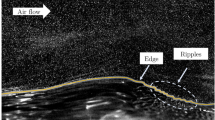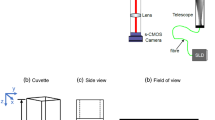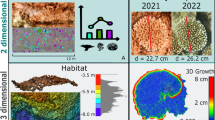Abstract
In this study, we investigate the nature of a Reynolds ridge formed by wind shear. We have simultaneously imaged the water surface, with a deposit of a monolayer of the surfactant, oleyl alcohol, subject to different wind shears, by using a high-resolution infrared (IR) detector and a high-speed (HS) digital camera. The results reveal that the regions around the wind-driven Reynolds ridge, which have subtle manifestations in visual imagery, possess surprisingly complex hydrodynamical and thermal structures when observed in the infrared. The IR measurements reveal a warm, clean region upstream of the ridge, which is composed of the so called fishscale structures observed in earlier investigations. The region downstream of the ridge is composed of colder fluid which forms two counter-rotating cells. A region of intermediate temperature, which we call the mixing (wake) region, forms immediately downstream of the ridge near the channel centerline. By measuring the velocity of the advected fishscales, we have determined a surface drift speed of about 2% of the wind speed. The spanwise length-scale of the structures has also been used to estimate the wind shear. In addition, a comparison of IR and visual imagery shows that the thermal field is a very sensitive indicator of the exact position of the ridge itself.





Similar content being viewed by others
References
Cheung TK, Street RL (1988) The turbulent layer in the water at an air-water interface. J Fluid Mech 194:133–151
Edser E (1926) General physics for students: A text-book on the fundamental properties of matter. Macmillan, London, pp 636–645
Ewing G, McAlister ED (1960) On the thermal boundary layer of the ocean. Science 131:1374–1376
Franklin B, Brownrigg W, Farish (1774) Of the stilling of waves by means of oil. Extracted from sundry letters between Franklin, Brownrigg, and the Reverend Mr. Farish. Philos T (1683–1775) 64:445–460
Handler RA, Smith GB, Leighton R (2001) The thermal structure of an air-water interface at low wind speeds. Tellus 53A:233–244
Handler RA, Leighton RI, Smith GB, Nagaosa R (2003) Surfactant effects on passive scalar transport in a fully developed turbulent flow. Int J Heat Mass Tran 46:2219–2238
Harper JF, Dixon JN (1974) In: Proceedings of the 5th Australasian conference on hydraulics and fluid mechanics, Christchurch, New Zealand, pp 499–505
Langmuir I (1938) Surface motion of water induced by wind. Science 87:119–123
Langton J (1872) Ripples and waves. Nature 5:241–242
Leibovich S (1983) The form and dynamics of Langmuir circulations. Annu Rev Fluid Mech 15:391–427
McCutchen CW (1970) Surface films compacted by moving water: Demarcation lines reveal film edges. Science 170:61–64
Reynolds O (1900) Paper on mechanical and physical subjects. Reprinted from various transactions and journals, vol 1. Cambridge University Press, Cambridge, pp 411–412
Romano JC (1996) Sea-surface slick occurrence in the open sea (Mediterranean, Red Sea, Indian Ocean) in relation to wind speed. Deep-Sea Res, Part I 43(4):411–423
Satterly J, Turnbull R (1929) The ridge at the junction of clean and contaminated liquid surfaces. T Roy Soc Can 23:95–118
Saunders PM (1969) The temperature at the ocean-air interface. J Atmos Sci 24:269–273
Saylor JR, Smith GB, Flack KA (2000a) Infrared imaging of the surface temperature field of water during film spreading. Phys Fluids 12:597–602
Saylor JR, Smith GB, Flack KA (2000b) The effect of a surfactant monolayer on the temperature field of a water surface undergoing evaporation. Int J Heat Mass Tran 43:3073–3086
Scott JC (1972) The influence of surface-active contamination on the initiation of wind waves. J Fluid Mech 56(3):591–606
Scott JC (1982) Flow beneath a stagnant film on water: The Reynolds ridge. J Fluid Mech 116:283–296
Sellin RHJ (1968) Existence of a surface tension discontinuity at a liquid free surface. Nature 217:536–538
Smith GB, Leighton RI, Tang ST (1998) Turbulent transition in the infrared. Phys Fluids 10(9):S9-S9
Veron F, Melville WK (2001) Experiments on the stability and transition of wind-driven water surfaces. J Fluid Mech 446:25–65
Vogel MJ, Hirsa AH, Kelley JS, Korenowski GM (2001) Simultaneous measurement of free-surface velocity and surfactant concentration via a common laser probe. Rev Sci Instrum 72(2):1502–1509
Vogel MJ, Hirsa AH (2002) Concentration measurements downstream of an insoluble monolayer front. J Fluid Mech 472:283–305
Warncke A, Gharib M, Roesgen T (1996) Flow measurements near a Reynolds ridge. J Fluid Eng-T ASME 118:621–624
Warncke A, Gharib M (2000) Experimental study of the wake behind a surface-piercing cylinder for a clean and contaminated free surface. J Fluid Mech 402:109-136
Wick GA, Emery WJ, Kantha LH, Schlussel P (1996) The behavior of the bulk-skin sea surface temperature difference under varying wind speed and heat flux. J Phys Oceanogr 26(10):1969–1988
Woodcock AH (1941) Surface cooling and streaming in shallow fresh and salt water. J Mar Res 4(2):153–161
Acknowledgement
We thank Professor K.A. Flack at the United States Naval Academy for lending us the wind tunnel. We also want to thank Dr. C. Trump for help in constructing the wind-wave tunnel. This work is supported by the National Research Council through the Naval Research Laboratory, and the Office of Naval Research.
Author information
Authors and Affiliations
Corresponding author
Rights and permissions
About this article
Cite this article
Phongikaroon, S., Peter Judd, K., B. Smith, G. et al. The thermal structure of a wind-driven Reynolds ridge. Exp Fluids 37, 153–158 (2004). https://doi.org/10.1007/s00348-004-0794-2
Received:
Accepted:
Published:
Issue Date:
DOI: https://doi.org/10.1007/s00348-004-0794-2




